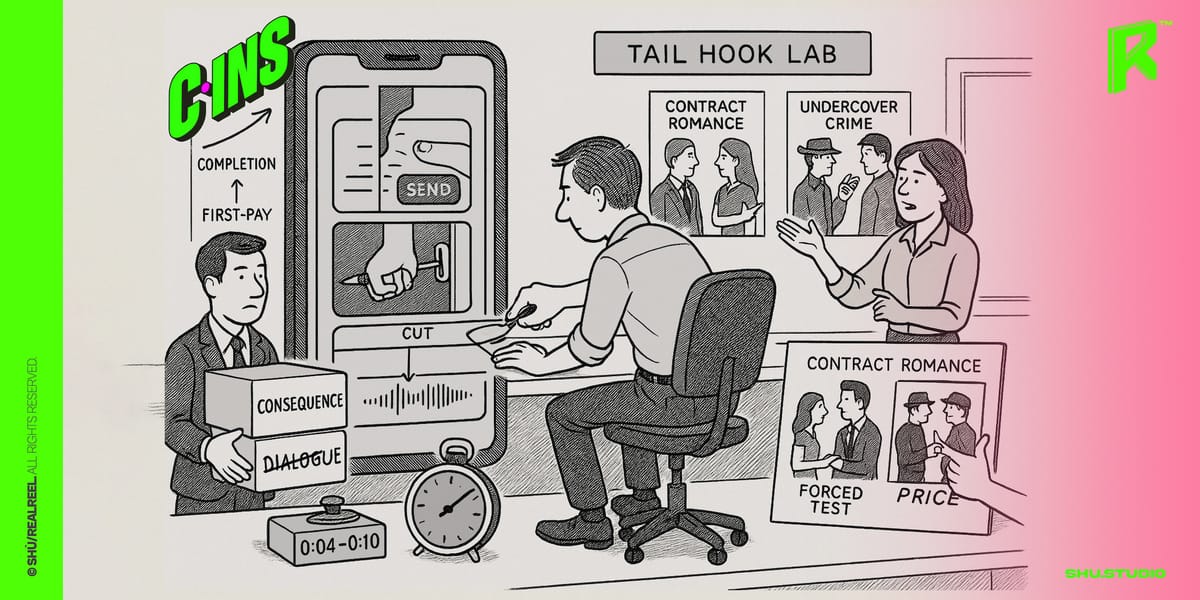Cut on Consequence: Tail Hooks That Drive the Next Tap
Tail Hooks That Drive the Next Tap: Trade playbook for vertical drama: cut on action, leak fallout under black, answer in 10s, pivot by :45, objects carry cost, faces carry payoff.

Openings win impressions; endings win revenue.
In vertical drama, the last 10–15 seconds now decide first-pay and whether viewers keep rolling. Rooms that cut on consequence, not on dialogue, are pulling ahead.
The problem has shifted.
The sector has largely cracked the cold open: bold first frames, frictionless premise delivery, a quick hit of tone. Yet conversion still sags around the minute mark. The difference maker isn’t a louder promise; it’s a cost already in motion when the episode cuts.
Call it tail-hook engineering: design the consequence, show it begin, then make the next episode pay immediately.
Why it matters
Platforms track the same three beats: completion → first-pay → multi-pay. Completion proves you held attention; first-pay tells you the tail hook felt non-optional; multi-pay confirms you paid it off without stalling. Teams seeing steady lifts have two habits in common: they end on the start of an act (pen hits paper, thumb depresses “send,” trigger begins to travel) and they answer within ten seconds when viewers come back, pivoting to a fresh problem by the 45-second mark.
The edit-room standard is changing
The old cliffhanger: end on a line, tease a secret, reads thin on phones. Editors are standardizing a new grammar:
- Cut on consequence, not on talk. The last intelligible word is rarely the out. Frames land as an irreversible move begins.
- Let fallout leak under black. A single pre-lapped sound, security gate slam, reporter scrum, phone buzz, signals the cost without explaining it.
- Anchor on a physical edge. Contracts, door chains, UI load bars: objects photograph cleanly and imply action. Faces carry feeling; objects carry price.
What actually plays by genre
Patterns are emerging, not clichés, but repeatable shapes that travel well in 9:16.
- Contract/office romances: the document beat. A signature, stamp, or page-two twist works only when paired with public exposure (cameras popping, a rival entering with keys).
- Family/chaebol sagas: the public choice. Banquets, votes, will readings: shame and status make the consequence visible.
- Crime/undercover: the forced test. The cut lands on obedience or betrayal starting, never on a speech about loyalty.
- Heist/procedural: tool vs. gate. Drill kisses vault, keycard blinks red, a timer audibly starts.
- Supernatural: the threshold cross. Door chain, mirror edge, salt circle, end on the first frame of crossing, not the lore that precedes it.
When numbers dip, the fixes are practical
Completion drops at 65–80 seconds usually mean a meandering corridor: too many motions, not enough change. Cut a step and add one can’t-undo action (send, sign, step). Strong completion but soft first-pay? You ended on information, not consequence, swap a puzzle for a price. Early churn in the next episode? You “paid” with dialogue. Show the outcome in the opening seconds, then light a new problem before :45.
The takeaway
This isn’t about louder teases. It’s about where you cut and what that cut implies. End as the cost begins, let a trace of fallout ride the black, pay it back immediately, and turn the wheel to a fresh engine before the halfway mark. Do it consistently and “continue” taps stop looking random: they start looking earned.
Real Reel™ Newsletter:







